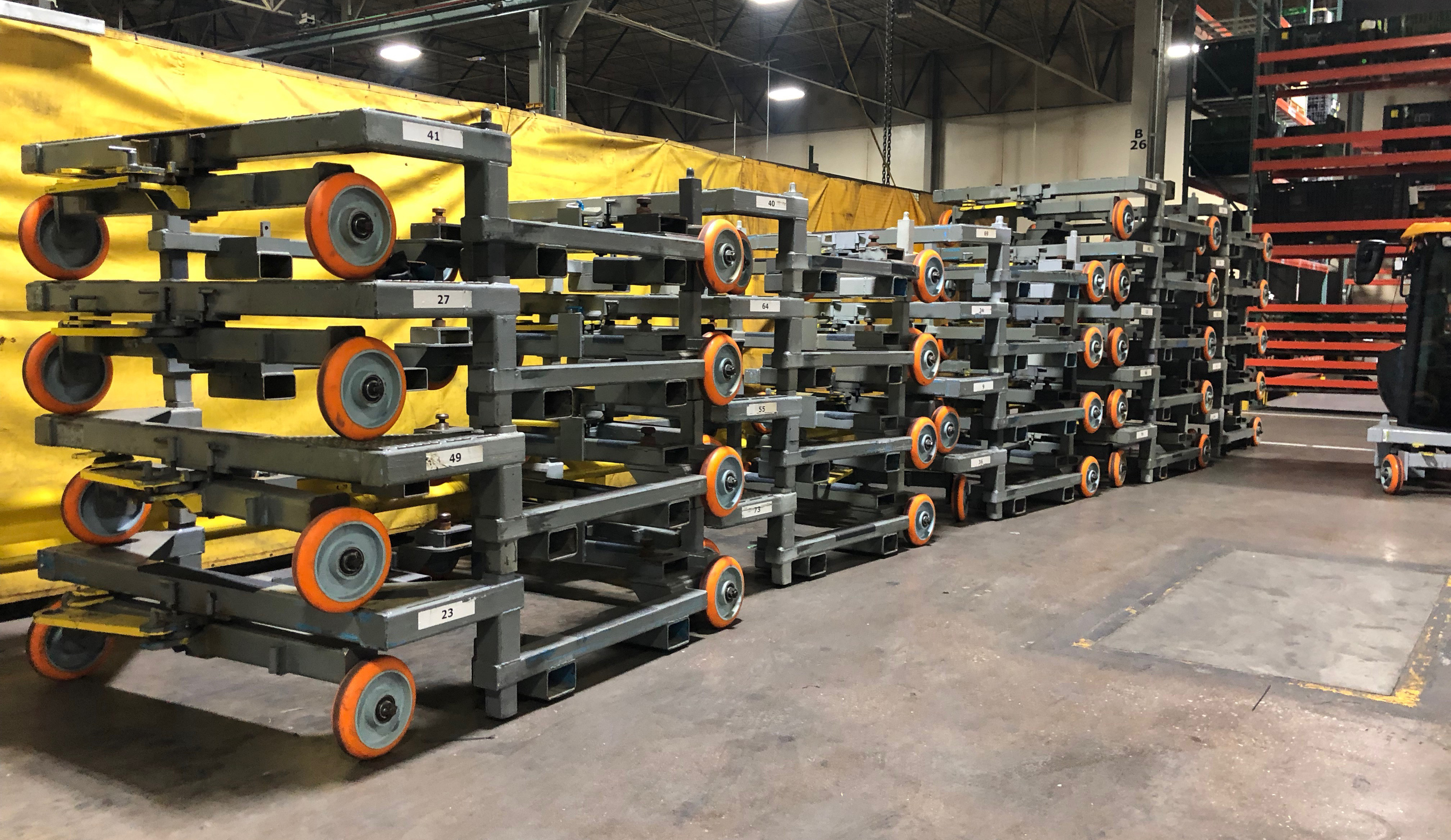How to Build a Smart Caster Replacement Strategy

If your facility waits for casters to fail before replacing them, you are already losing time and money.
Casters are essential to mobility on the shop floor. They keep carts moving, materials flowing, and operations running efficiently. Yet, in many facilities, caster maintenance is not part of the preventive maintenance (PM) checklist. That gap can lead to avoidable equipment failures, worker injuries, and costly downtime.

Caster failure is avoidable with the right planning and maintenance. A smart caster replacement strategy can improve ergonomics, extend equipment life, and reduce delays across your operation.
This guide outlines a practical framework to help you develop a proactive caster replacement plan, including:
-
Timing caster inspections with your existing PM schedule
-
Identifying high-risk areas that cause faster caster wear
-
Training your team to recognize early signs of failure
-
Stocking replacements strategically to avoid last-minute disruptions
Step 1: Align Caster Inspections with Preventative Maintenance

Most maintenance teams already schedule regular inspections for motors, belts, HVAC systems, and safety equipment. Casters should be treated the same way.
By integrating caster checks into your PM workflow, you ensure that mobility issues are addressed before they lead to downtime. Inspection frequency depends on caster usage and operating conditions:
-
Weekly for high-volume or heavy-duty applications
-
Monthly for general production carts
-
Quarterly for light-duty or infrequently moved equipment
Also consider seasonal shifts. Winter may bring frozen floors, while peak seasons like holidays often increase cart traffic and load volume.
Adding casters to your digital or printed PM checklist helps reinforce accountability. If it is not on the list, it is likely being overlooked.
Step 2: Identify High-Risk Zones in Your Facility

Casters do not wear out evenly across a facility. Some areas place more stress on wheels, bearings, and rig components than others. Identifying those high-risk zones allows you to prioritize inspections and replacements where they matter most.
Environments that accelerate caster wear:
-
Loading docks: Curb impacts, uneven pavement, and frequent stops
-
Wet or freezer zones: Moisture exposure and slippery floors
-
Heavy equipment areas: Static load, shock loading, and side-impact stress
-
Towed carts: Lateral pressure that shortens swivel life and damages bushings
Red flags to watch for:
-
Repeat caster failures in the same department
-
Flooring damage in specific zones
-
Increased worker strain or push complaints
Mapping out your facility’s most demanding environments helps focus your resources and reduces repeat failures.
Step 3: Train Staff to Spot Pre-Failure Wear

Many caster failures can be prevented with early detection. Issues like worn bearings, flat spots, or alignment problems typically show warning signs before a full breakdown occurs. However, these signs are often overlooked unless team members know what to watch for.
By educating your staff on how to identify early symptoms, you can catch problems before they cause safety risks, slowdowns, or equipment damage.
Common pre-failure indicators include:
-
Flat spots on wheels, often caused by repeated heavy loads or abrupt stops
-
Unusual noises during movement, such as grinding, squeaking, or thumping
-
Wobbling or vibration that makes carts harder to steer or control
-
Visible rust or grease leakage, pointing to bearing failure
-
Carts that drift, veer, or are harder to steer, usually due to misalignment or uneven wear
Debris buildup around wheels or rigs that increases resistance or blocks rotation
Providing a quick reference checklist for these signs helps teams recognize issues during regular use or scheduled inspections. This kind of proactive awareness is a key part of any effective caster maintenance program.
Step 4: Stock Smarter to Minimize Downtime

Caster failures can halt productivity, especially when replacements are not readily available. That is why a proactive inventory strategy is just as important as a regular inspection schedule. By planning ahead, you can reduce delays, avoid costly emergency orders, and keep your equipment moving.
Start by looking at your most commonly used carts and equipment. Identify the caster types, environments, and load ratings associated with each. From there, build an inventory plan that emphasizes consistency, speed, and simplicity.
Best practices for caster inventory planning:
-
Standardize casters across similar carts to reduce SKU complexity
-
Use color-coded labels or part tags to quickly identify load ratings or designated use zones
-
Stage replacement casters near high-traffic areas to enable fast swaps without added steps
A well-managed inventory reduces mismatches during replacements, shortens training time for new techs, and eliminates the need for last-minute shipping when a caster fails. Partnering with your caster supplier can help you build a tailored stocking plan that fits your space, usage patterns, and operational needs.
Step 5: Build and Execute Your Replacement Plan

Once you have assessed your environment, identified failure patterns, and stocked strategically, the next step is turning that insight into action. A successful caster replacement plan should be easy to implement, repeatable across teams, and aligned with your existing MRO systems.
The goal is to ensure that caster maintenance is no longer reactive. With a structured approach, your team can stay ahead of wear issues, reduce downtime, and extend the lifespan of your equipment.
Here is a simple six-step framework to help you put your plan into motion:
-
Audit your caster usage. Document where different caster types are used, how frequently, and in what conditions.
-
Label high-traffic carts. Use asset tags, QR codes, or simple visual indicators to simplify inspection and track service history.
-
Train operators and techs. Ensure your team can recognize early warning signs and report issues before failure occurs.
-
Integrate inspections. Add caster checks to your preventive maintenance schedule, especially in high-risk zones.
-
Stock strategically. Keep fast-moving and high-risk casters close to the point of use, and reduce variety where possible.
-
Work with a partner. An experienced caster supplier can help you choose the right products, improve standardization, and reduce long-term maintenance costs.
By putting this plan into action, you build resilience into your mobility infrastructure and create a more efficient, safer operation.
A Strategic Approach Pays Off

Effective caster replacement starts long before wheels begin to fail. The key is building a proactive plan that reduces risk and keeps your operation running at full speed.
By planning ahead, training your team, and keeping the right stock on hand, you can reduce unplanned downtime, improve ergonomics, and extend the lifespan of your equipment.
Casters may be small, but their impact on safety, productivity, and facility flow is significant. Whether you are just getting started or improving an existing maintenance program, the right strategy will make every shift more efficient.
Need Help Optimizing Your Caster Strategy?
A smart replacement plan starts with insight and the right support.
If you're not sure which casters fit your carts, facility zones, or workload demands, our team can help. At Caster Connection, we offer Caster Needs Eval, our free consultative service to assess your current setup and recommend solutions tailored to your environment, equipment, and long-term goals.
Whether you need help reducing injury risk, minimizing downtime, or standardizing your caster inventory, we’re here to help.
Contact us to start building a caster strategy that keeps your operation rolling smoothly.
